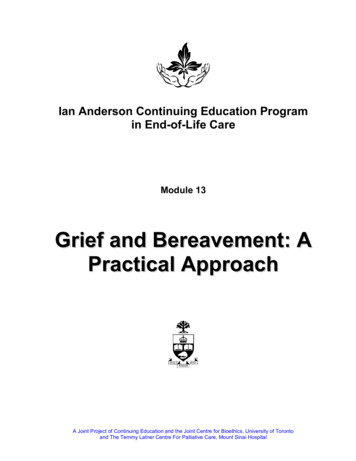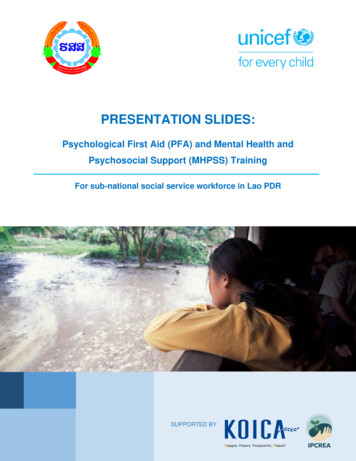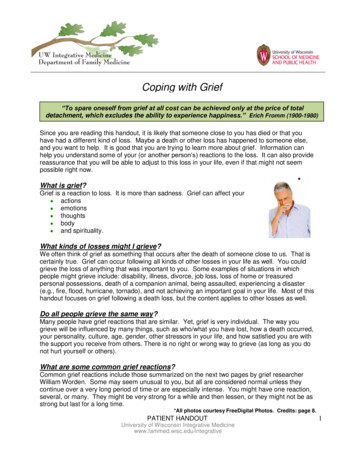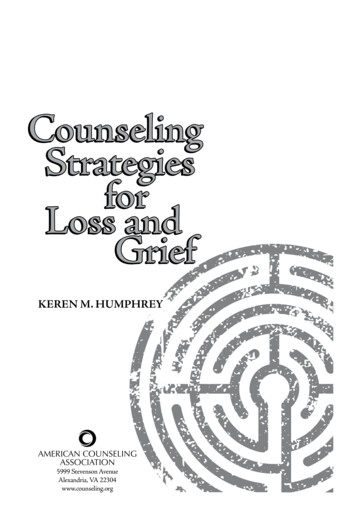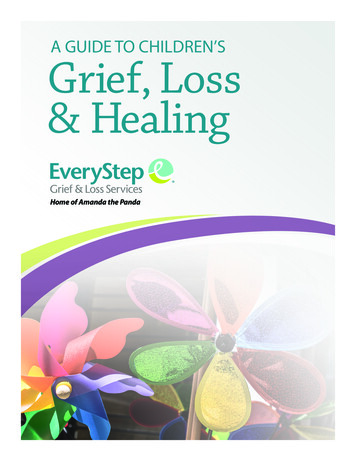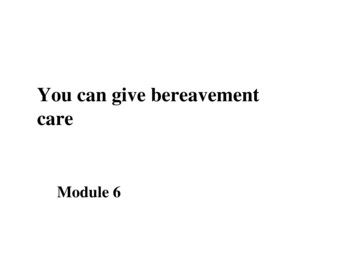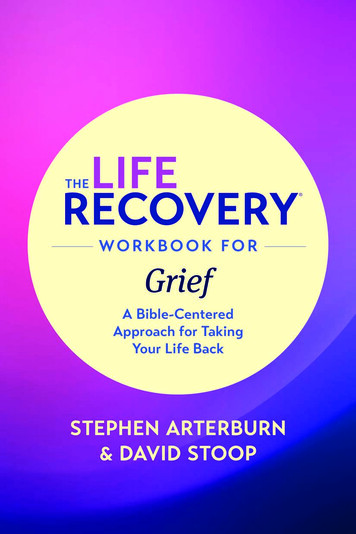
Transcription
THEWORKBOOK FORGriefA Bible- CenteredApproach for TakingYour Life BackSTEPHEN ARTERBURN& DAVID STOOPTyndale House PublishersCarol Stream, Illinois
Visit Tyndale online at liferecovery.com and www.tyndale.com.TYNDALE, Tyndale’s quill logo, and Life Recovery are registered trademarks of Tyndale HousePublishers.The Big Book is a registered trademark of A.A. World Services, Inc.The Life Recovery Workbook for Grief: A Bible-Centered Approach for Taking Your Life BackCopyright 2020 by Stephen Arterburn and David Stoop. All rights reserved.Cover photograph of purple abstract copyright AVER/Depositphotos.com. All rights reserved.Cover design by Dan FarrellEdited by Ellen Richard VosburgThe author is represented by the literary agency of Alive Literary Agency, 7680 Goddard Street,Suite 200, Colorado Springs, CO 80920, www.aliveliterary.com.Unless otherwise indicated, all Scripture quotations are taken from the Holy Bible, New LivingTranslation, copyright 1996, 2004, 2015 by Tyndale House Foundation. Used by permissionof Tyndale House Publishers, Carol Stream, Illinois 60188. All rights reserved.Scripture quotations marked KJV are taken from the Holy Bible, King James Version.Scripture quotations marked TLB are taken from The Living Bible, copyright 1971 by TyndaleHouse Foundation. Used by permission of Tyndale House Publishers, Carol Stream, Illinois60188. All rights reserved.Scripture quotations marked MSG are taken from THE MESSAGE, copyright 1993, 2002, 2018by Eugene H. Peterson. Used by permission of NavPress. All rights reserved. Represented byTyndale House Publishers.Scripture quotations marked NASB are taken from the New American Standard Bible, copyright 1960, 1962, 1963, 1968, 1971, 1972, 1973, 1975, 1977, 1995 by The Lockman Foundation.Used by permission.Scripture quotations marked NIV are taken from the Holy Bible, New International Version, NIV. Copyright 1973, 1978, 1984, 2011 by Biblica, Inc. Used by permission. All rightsreserved worldwide.The brief excerpts from Alcoholics Anonymous and the Twelve Steps are reprinted and adaptedwith permission of Alcoholics Anonymous World Services, Inc. Permission to reprint and adaptthe Twelve Steps does not mean that AAWS has reviewed or approved the contents of thispublication, or that AAWS necessarily agrees with the views expressed herein. A.A. is a programof recovery from alcoholism only— use of the Twelve Steps in connection with programs andactivities which are patterned after A.A., but which address other problems, or in any other non- A .A. context, does not imply otherwise. Additionally, while A.A. is a spiritual program, A.A.is nota religious program. Thus, A.A. is not affiliated or allied with any sect, denomination, or specificreligious belief.The profiles in this workbook are composite characteristics of persons who have had the courageto work the steps on various issues in their lives and on their own addictive behaviors. Names,ages, and situations have been modified to protect their anonymity.For information about special discounts for bulk purchases, please contact Tyndale HousePublishers at csresponse@tyndale.com, or call 1-800-323-9400.ISBN 978-1-4964-4213-0Printed in the United States of America267256245234223212201
This workbook is dedicated to every fellow struggler who has had thecourage to face the truth about themselves, the humility to abandontheir flawed attempts at living, and the willingness to find God’struth and live accordingly.
CONTENTSThe Twelve Steps of Alcoholics AnonymousThe Twelve StepsIntroductionviviiixSTEP ONE1STEP TWO 13STEP THREE 21STEP FOUR 29STEP FIVE 39STEP SIX 47STEP SEVEN 57STEP EIGHT 67STEP NINE 77STEP TEN 87STEP ELEVEN 97STEP TWELVE 107Scripture Index 117
The Twelve Steps of Alcoholics Anonymous1. We admitted we were powerless over alcohol— thatour lives had become unmanageable.2. Came to believe that a Power greater than ourselvescould restore us to sanity.3. Made a decision to turn our will and our lives overto the care of God as we understood Him.4. Made a searching and fearless moral inventory ofourselves.5. Admitted to God, to ourselves, and to anotherhuman being the exact nature of our wrongs.6. Were entirely ready to have God remove all thesedefects of character.7. Humbly asked Him to remove our shortcomings.8. Made a list of all persons we had harmed, andbecame willing to make amends to them all.9. Made direct amends to such people whereverpossible, except when to do so would injurethem or others.10. Continued to take personal inventory and whenwe were wrong promptly admitted it.11. Sought through prayer and meditation to improveour conscious contact with God as we understoodHim, praying only for knowledge of His will for usand the power to carry that out.12. Having had a spiritual awakening as the resultof these steps, we tried to carry this message toalcoholics, and to practice these principles in allour affairs.Copyright A.A. World Services, Inc.vi
The Twelve Steps1. We admitted that we were powerless over ourproblems and that our lives had becomeunmanageable.2. We came to believe that a Power greater thanourselves could restore us to sanity.3. We made a decision to turn our wills and our livesover to the care of God.4. We made a searching and fearless moral inventoryof ourselves.5. We admitted to God, to ourselves, and to anotherhuman being the exact nature of our wrongs.6. We were entirely ready to have God remove thesedefects of character.7. We humbly asked God to remove our shortcomings.8. We made a list of all persons we had harmed andbecame willing to make amends to them all.9. We made direct amends to such people whereverpossible, except when to do so would injure themor others.10. We continued to take personal inventory, and whenwe were wrong, promptly admitted it.11. We sought through prayer and meditation toimprove our conscious contact with God, prayingonly for knowledge of his will for us and the powerto carry it out.12. Having had a spiritual awakening as a result ofthese steps, we tried to carry this message to others,and to practice these principles in all our affairs.The Twelve Steps used in The Life Recovery Workbook have been adapted withpermission from the Twelve Steps of Alcoholics Anonymous.vi i
INTRODUCTIONI am bent over and racked with pain. All day long I walkaround filled with grief. (Psalm 38:6)This workbook is about transformation from the deathgrip of grief to the restoration of life. It’s about walking humbly,righteously, and mercifully with God while accepting his will.Often in our grief we oppose God, argue with him, plead withhim for healing, and methodically cut other people out ofour lives. We end up separated from God and from the peoplewho care for us. We feel abandoned by all. The Twelve Stepsare a path of finding that humble walk that leads us out of self- centered grief to acceptance and to a closer relationshipwith God.We will be examining the Twelve Steps individually to consider the challenging spiritual lessons that allow us to movebeyond our grief. Each step has a new task for us in our recoveryfrom grief, but none of the steps stand alone. To effectively movethrough our grief to acceptance, we will work the steps in order.Each step prepares us for the next one, as we develop a greatersense of openness to God’s plan and purpose in our lives.We can get stuck in the grief process. But the path of recoveryleads us through the grief process to a healthy acceptance of ourloss. We see the Twelve Steps as a path and a process that makesus better disciples and more committed followers of Jesus Christ.Honesty, humility, and courage are vital components of faith thatcan move us beyond the grief of our losses back to a vibrant wayof living as a follower of Jesus. Welcome to the journey.ix
L IF E RECOV ERY: GRI E FSTARTING AND LEADING A GROUPRecovery is best experienced in the context of a group. Two ormore willing people can form a powerful bond as they studyand work these steps together. With little effort on your part,your struggles, problems, and hang- ups become a blessing tothe group. As you open up, everyone else will feel more free toshare from their own lives.Being the leader of a group is actually quite simple. You canfind many books on how to lead a small group, but here’s asimple and effective way to do it:1. Find a location in your home, a church, workplace, or school,and obtain permission (if necessary) to form the group.2. Put up a few flyers announcing the time and place, calling ita grief support group, recovery group, or Twelve Step group.3. Show up early, arrange the chairs, make some coffee, andwelcome people as they arrive.4. Start when you say you will start by opening in prayer andby reading the Twelve Steps and the correlating Scriptures.5. Ask if anyone would like to share for three or four minutes.Don’t allow others to “fix” the speaker, and if he or shegoes on too long, be sure to enforce the time limit.6. Make sure everyone has a copy of the workbook. Ask themto study Step One for discussion at the next meeting.7. End when you say you will end by reading the Lord’s Prayer.8. Be sure that everyone knows where to get a workbook anda Life Recovery Bible, if they don’t already have one.9. E- mail Stephen Arterburn (Steve) at sarterburn@newlife. com, and tell him how it’s going.10. Feel good that you are allowing God to use you.Please remember that working the steps is an art, not a formula.Most often, it is an individualized process.God be with you on this journey. We pray that you will findhealing, serenity, and peace of mind.x
S T E P1PROFILESarah had a problem with anger. She had no idea whereher anger came from. She just figured she was an angry person. But when she ruined her second computer by throwing itagainst the wall in anger, she realized she had a problem, andshe didn’t know what to do about it. Nothing she tried hadreduced the intensity of her rage. She finally faced the realitythat she needed someone to help her, so she made an appointment with a counselor.Listening to Sarah’s life story, the counselor took notice ofthe early death of Sarah’s father and the relatively early deathof her mother. When Sarah finished describing her background,the counselor returned to the subject of her parents’ deaths.The counselor was particularly struck by the fact that wheneverSarah talked about her father, she would weep. But whenevershe talked about her mother, she tried to hide the undercurrentof rage that she was experiencing.Sarah’s father had died when she was nine years old. He washer hero. He had lost one of his legs in the Korean War, but hehad never let that slow him down. She was his little princess,and she was devastated when he died. But no one seemed tonotice that Sarah was struggling with her emotions becauseall the adults were consumed by their own grief, especially hermother. So Sarah had to deal with the loss of her father on her1
L IF E RECOV ERY: GRI E Fown. She recalled how she would cry herself to sleep, night afternight, for what felt like several years.Her mother’s response to her husband’s death was to beginliving her life through Sarah. Sarah was an only child, andeverywhere her mother went, Sarah went with her. At first thiswas okay, but when Sarah became a teenager, she was oftenhumiliated in front of her friends by how controlling hermother was. Even when they went to church, Sarah was forcedto sit with her mother, whereas all the other teenage girls satas a group. Sarah begged and pleaded with her mother to lether sit with her friends in church and to spend time with herfriends during the week, but Sarah’s mother always respondedwith sadness and tears. Soon Sarah’s begging and pleadingturned into yelling and screaming. When Sarah was t wenty- five,her mother died. Sarah felt relieved and had to force herself togo to the funeral.Her counselor understood that complete grieving involvesthe experience of both anger as a protest and sadness as a senseof resignation. Acceptance of the loss is the final stage of grieving. The counselor realized that Sarah was experiencing incomplete grieving in relation to the deaths of both her father andher mother. In relationship to her father, she experienced onlysadness. In response to her mother’s death, she experiencedonly anger as a protest.So the counselor began to talk to Sarah about things thatshe had missed due to her father’s early death. When thecounselor hit on the fact that, due to her father’s early death,she was exposed to her mother’s smothering behavior, it ranga bell in Sarah. If her dad had lived, she’d have had a very different relationship with her mother. Gradually Sarah beganto see her father’s death as both sad and something to protestwith anger.In the same way, the counselor began to challenge her to seeher mother as being weak and needy and unable to acknowledge her own problems. Sarah began to feel a sense of sadness2
ST E P O nefor what she had lost in her relationship with her mother.Eventually, Sarah was able to feel some anger as protest overthe incredible loss of her father at such a young age and to feelsome sadness at the limitations she experienced in her relationship with her mother.It took some time for Sarah to complete the grieving process for each of her parents. But along the way, she noticedthat she was not as troubled by the out- of- control anger thatshe had experienced previously, which led her to get intocounseling. Now, ten years later, Sarah hasn’t ruined a singlecomputer. In fact, she very seldomly gets angry, and she cantalk about her father without crying. She can also talk abouther mother without getting angry. She worked through theprocess of grieving to reach acceptance. Sarah was powerlessto solve the issue by herself, but she wisely chose to get help,and God worked through her counselor to help Sarah getbeyond her powerlessness.STEP ONEWe admitted we were powerless over our problemsand that our lives had become unmanageable.It’s interesting that the first word in the first step is we.I can’t work on my problems in my life on my own. The resolution comes through the we. One of the things Sarah had doneover the years was to increasingly isolate herself from relationships with other people in order to hide her rage. Then, if herrage suddenly got out of control, no one would be around to seeit. She was powerless, but she was not helpless. So she got help.The Twelve Steps teach us that recovery and healing always takeplace in the context of the we.Spiritual transformation always begins in community. At thestart of Jesus’ ministry, he began to gather people around him ashis disciples. The power of the early church in the book of Actsis directly related to their reputation for how they loved one3
L IF E RECOV ERY: GRI E Fanother. So even grieving needs to take place in some sort ofcommunity, whether that community is an official grief supportgroup or simply a family gathering around each other and staying connected as they grieve.The key point of Step One is the reality of our powerlessness. It’s not a term we like. In fact, it’s an experience that weseek to avoid as much as possible. But when it comes to grieving over our losses, we are all too often confronted with thereality of our powerlessness to do anything about what hasbeen lost. When we have lost someone or something important, especially a loved one, we are truly powerless.We can even experience powerlessness when we lose something that seems small. One time, I (Dave) lost a treasured oldfountain pen in a restaurant. But no matter how many timesI went back to the restaurant to look for it, it was gone. I waspowerless to do anything about it. I even offered a reward forits return. I talked to the waiters and waitresses. But no matterwhat I did, I was confronted with the fact that I had no power.I was powerless.When someone I love is lying in a hospital bed on the vergeof death, no matter how much I plead with the doctors or howmuch I pray, I am confronted with my own powerlessness inthe face of loss. In those circumstances, even the doctors oftenacknowledge their powerlessness to do anything to avoid theinevitable. So the first step of grieving is to come to terms withour powerlessness.Some of our losses are obvious: I lost my fountain pen; I lostmy friend to cancer. But there are other losses that are not soobvious. For example, I lost my image of myself when I lost myfountain pen because I thought I was so careful with that pen.I lost a sense of connection when my friend died and left mehere without him. When my children grew up and moved outof our house, I lost the sense of connection we had when welived under the same roof. When we moved across the country,4
ST E P O neI lost a sense of familiarity with where I lived, and I lost a circleof friends.When we look at how people grieved in the Bible, they hadcertain rituals and behaviors that they followed. Perhaps thatmitigated some of the powerlessness they were feeling. Forexample, when someone died, those who were mourning toretheir clothes and put on burlap. Sometimes they shaved theirheads or they threw ashes on themselves. It’s almost as if theyfelt like they had to do something in the midst of their grief toavoid the feeling of powerlessness.The account of Job’s suffering teaches us some importantthings about grief. When Job received word that all of his animals were gone, that his sons and daughters were all dead, thatall his sheep and the shepherds were gone, that all his camelswere gone, and that almost all of his servants were killed, theBible says that Job “stood up and tore his robe in grief. Then heshaved his head and fell to the ground to worship” ( Job 1:20).Job responded, “I came naked from my mother’s womb, andI will be naked when I leave. The Lord gave me what I had,and the Lord has taken it away. Praise the name of the Lord!”( Job 1:21). It’s interesting that in his grief Job also worshiped— h e stayed connected to God.Job had to acknowledge his powerlessness because everything had already happened by the time he heard, and therewas nothing he could do. All his cattle were gone, his servantswere gone, all his children were gone, and all his wealth wasgone. There was nothing he could do about any of it!But he had friends, and three of them came to comfort andconsole him. He wasn’t going to be alone. The three friendssat in silence with him, which was the perfect response. Whenyou’re grieving, you don’t want a lot of conversation. The passage says, “They sat on the ground with him for seven days andnights. No one said a word to Job, for they saw that his suffering was too great for words” ( Job 2:13). Then Job spoke, andthe silence was broken.5
L IF E RECOV ERY: GRI E FThen Job was angry. When he spoke, he first cursed the dayof his birth. He wished he had never been born. From the sadness of chapters 1 and 2 to the anger of chapter 3, Job has beengrieving. And Job’s friends are going to make him even moreangry. At one point, Job says to them, “How long will you torture me? How long will you try to crush me with your words?You have already insulted me ten times. You should be ashamedof treating me so badly” ( Job 19:2-3). The friends meant well,but their responses didn’t comfort Job.Job was protesting his innocence, and he directed his arguments at God. And finally, when God begins to respondto Job, he doesn’t criticize Job for arguing. Instead, God asksJob a series of questions that cover four chapters— questionsJob cannot answer, for the questions are too profound. Wecannot answer some of these questions to this day. God confronted Job with his powerlessness. When God is finished,Job says,“I know that you can do anything, and no one can stopyou. You asked, ‘Who is this that questions my wisdomwith such ignorance?’ It is I— and I was talking aboutthings I knew nothing about, things far too wonderfulfor me. You said, ‘Listen and I will speak! I have somequestions for you, and you must answer them.’ I hadonly heard about you before, but now I have seen you withmy own eyes. I take back everything I said, and I sit indust and ashes to show my repentance.” ( Job 42:1-6,emphasis added).What is it that Job learned from his powerlessness? Forone, even though he was powerless, he was talking to a verypowerful God. And he repented for having too small an imageof God. That’s something we can learn from Job. When we aretruly powerless, we are open to the almighty power of Godhimself. There’s no sense by which I can do it myself: I can doit only with God’s help.6
ST E P O neBut is it okay to argue with God? God says it is. He told Jobto go pray for his friends because they did not speak rightlyabout him. But Job was not corrected or criticized for all of hisarguing with God! So Job teaches us that it’s okay to argue withGod as long as we remember that we are arguing with a verybig, powerful God.One more important thing about powerlessness we learn fromJesus. In his ministry he highlighted the importance of children.At one point, some little children tried to come and visit Jesus,but his disciples tried to turn them away. Jesus stopped his disciples and said, “Let the children come to me. Don’t stop them!For the Kingdom of Heaven belongs to those who are like thesechildren” (Matthew 19:14). The Kingdom of Heaven belongs tothe little children who were basically powerless.We sometimes think that being powerless is like being a victim. It doesn’t make us a victim: It really just gets us out of theway for God to work. One of the major tasks in our grieving is tocome to terms with our powerlessness, for we are truly powerlesswhen we are dealing with our losses. But remember, like Sarahand Job, we are not helpless.QUESTIONS FOR STEP ONETrapped Genesis 16:1-151. How is my experience of powerlessness similar to Hagar’sexperience? How is it different?7
L IF E RECOV ERY: GRI E F2. How have I tried to escape from the pain of my grief?3. What has been my experience of anger in my grief? Whatscares me about my anger?4. How have I experienced sadness in my grief? What scaresme about my sadness?5. What are some of my fears about grieving this loss?8
ST E P O ne6. Where can I see God in this process of grieving right now?The Fruit of Grieving Genesis 41:50-521. Due to the jealousy and hatred of his brothers, Joseph wassold into slavery and ended up in Egypt. He managed toexcel in serving his master, but his master’s wife accused himof attempted rape. He spent several years in prison, until hewas finally released by Pharaoh. He became the secondmost powerful man in Egypt, and when he had children, hegave them meaningful names. Joseph named his second sonEphraim, which sounds like a Hebrew word meaning “fruitful,” because he said “God has made me fruitful in this landof my grief” (Genesis 41:52). What was Joseph’s fruitfulnessin Egypt, the land of his grief?2. What are some ways I can see God producing fruit in my lifein the midst of my grief?9
L IF E RECOV ERY: GRI E FAll Is Darkness Job 6:2-131. Job is very clear about the pain he was feeling. Describe thepain you’re experiencing in your grieving.2. In what ways have I felt totally powerless in my grief?3. In what ways have I tried to be faithful to God in the midstof my pain?4. How has Job’s experience helped me in experiencing mygrief?Worn Out from Sobbing Psalm 6:1-101. How does my sadness affect my relationships?10
ST E P O ne2. In what ways have others misunderstood my grief?3. David seems to project his anger onto God. That’s why we needto get comfortable expressing our anger in relationships, especially in our relationship with God. Remember, anger is a protest. In what ways have I brought my protest into relationship?4. Who in my circle of friends would be able to help me restoremy confidence in God?Like Little Children Mark 10:13-161. When I feel powerless, do I feel like a little child? How doesthat feel?2. When do I feel most cared for?11
L IF E RECOV ERY: GRI E F3. How does being childlike help me depend on God?The Paradox of Powerlessness 2 Corinthians 4:7-101. Remember some examples of when you have accepted yourown powerlessness and embraced God’s powerfulness.Describe them in this space below.2. How do I respond to trouble?3. How do I respond to being perplexed?4. What do I do when it feels like God has abandoned me?There is great power in realizingthat we are powerless.12
The Twelve Steps used in The Life Recovery Workbook have been adapted with permission from the Twelve Steps of Alcoholics Anonymous. vii. ix. INTRODUCTION I am bent over and racked with pain. All day long I walk around filled with grief. (Psalm 38:6) This workbook is about transformation from the death


